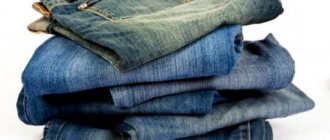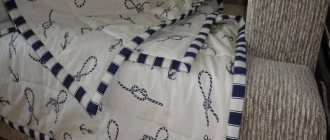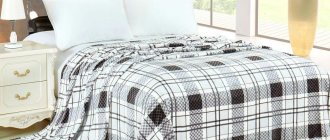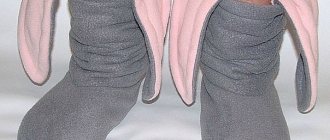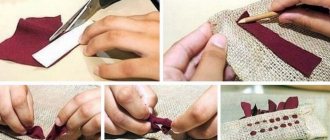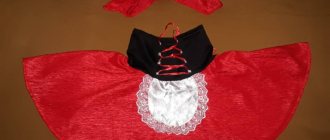According to statistics, every European wears out about two hundred pairs of jeans throughout his life. Fashion is constantly changing, the wardrobe is replenished with new models. But what to do with old jeans? It would be a shame to throw them away. A good solution would be to sew an original bedspread from your favorite old jeans. The fabric of these trousers is very durable and reliable. It can serve for decades without losing its attractiveness. There is no point in sending something like this to a landfill. It will make a beautiful bedspread for a bed or sofa.
The fabric from which the jeans are made is so practical that, even if slightly frayed, it does not lose its strength and attractiveness.
Detailed instructions for making a bedspread from old jeans are discussed in this publication.
What does a beginner need to know?
Making an original bedspread from old jeans with your own hands is relatively easy. This product is very similar to a mosaic consisting of dozens of pieces.
A blanket made from scraps of fabric that can be found in every home
During work, beginners must follow certain stages of work.
The first stage is the selection of basic materials and tools. You need to prepare everything you need in advance so as not to waste time searching for details during the process.
The second stage is the selection of a pattern and pattern. The pattern is selected based on the characteristics of the raw material and the wishes of the craftswoman.
Scheme of a patchwork double-sided bedspread with dimensions
There are many options for connecting patches. You can choose one of them and come up with something new. For beginners, it is better to use the simplest scheme, a ready-made pattern. A simple blanket made from old jeans will be just as attractive. You can practice while sewing it. Only after gaining a certain amount of experience will it be possible to use more complex schemes.
The third stage is washing and ironing. The product needs to be put in order. The bedspread should be washed delicately, avoiding high temperatures. A properly selected rinse aid will help make the product softer. After drying, the patchwork blanket made from old jeans should be thoroughly ironed using steam. The perimeter of the bedspread can be decorated with beautiful fringe and colored edging. A beginner can highlight interesting ideas on edging on the Internet, magazines, and specialized books.
Sewing instructions
Making a denim blanket from old fabric is considered a very painstaking job. To ensure that the final result does not disappoint, you must adhere to a certain sequence of actions.
Cutting patchwork blanks
A blanket made from denim scraps can be quickly sewn if you use a prepared stencil measuring 17x17. It will allow you to cut pieces of fabric more evenly.
It is best to cut using pre-prepared patterns
To do this you need to do the following:
- Attach the stencil to the fabric material.
- Using a pen, chalk or laundry soap, trace a pattern on the material.
- Cut the flap along the intended contour using sharp scissors.
When applying the pattern to denim, you must pay attention to the fact that the first side of the figure corresponds to the movement of the longitudinal thread, and the second - to the transverse thread. If this action is not performed, the blanket may tear after washing.
It is recommended to mark areas for stitching.
You will need to do the following manipulations:
- Apply a corner stencil to the corner of each flap from the front area.
- Insert a square blank with smaller parameters into the corner stencil.
- Remove the corner, outline the geometric figure on a light-colored fabric with a pencil, and on a dark-colored fabric with soap.
Assembling the bedspread
Due to the fact that it is very difficult to immediately distribute the shade of a large number of old denim products, it is recommended to place the image of the future bedspread on the floor surface. It is advisable to number all the squares so that during subsequent manipulations you do not make a mistake in their order.
Considering the number of squares of all shades, you can simulate the pattern of the blanket on the computer. Then it can be laid out according to a given pattern.
Stitching parts
Upon completion of assembling the bedspread, you can proceed to the stage of stitching the parts.
To do this you need to do the following:
- To obtain patchwork stripes, initially design the first row, then all the rest.
- When focusing on the outline of the element, fold, baste with thread and stitch.
- Thoroughly steam the prepared parts and straighten the ends of the squares in different directions.
- Stitch adjacent strips together.
Finishing of the finished canvas
To finish the resulting fabric, it is recommended to adhere to the following sewing instructions:
- Using a sewing machine, run a zigzag or even stitch along the lines of stitching the flaps.
- Stepping back 1 cm from the edge, run the sewing machine along each side of the sewn fabric.
- Regarding the side, remove the lobe threads and leave the transverse ones, or vice versa, spreading the ends of the squares that protrude.
- Decorate the entire perimeter of the bedspread with fringe.
Which pants are suitable?
You can sew a blanket from old jeans only from durable, high-quality fabric. Then it will have an attractive appearance. Raw materials must be selected taking into account some nuances:
- Worn parts of trousers cannot be used. They should be cut off and thrown away.
- The fabric should have a uniform shade. Then the bedspread will look amazing. Guests of the house will not be able to distinguish it from the purchased one.
- You can combine pants of different colors. However, the density of the fabric should be approximately the same.
- Items with damage or pockets should be cut out and thrown into a landfill. Such raw materials are unsuitable.
Choice of shape and size
Denim is a high-quality, durable material; you can sew a neat bedspread or a large blanket from old things. If denim pants are not enough, you can use unnecessary denim shirts, skirts, and jackets. The blanket is made according to the principle of a mosaic - it is assembled and sewn from individual fragments into a blanket of the desired shape and size. The advantage of sewing is that no special pattern is required. It is recommended to choose a simple layout of denim fragments and avoid too small flaps - they are difficult to sew and the finished product turns out to be heavy and bulky. Tips for choosing the shape and size of a blanket:
- if you need to sew a blanket for a sofa or bed with your own hands, you can base your calculations on the size of the finished textile;
- to calculate the required number of denim patches, draw a diagram of the plaid;
- when making a patchwork-style blanket, round blanks are cut out;
- Between the elements of the blanket you can lay cotton strips cut from old shirts.
Plaid scraps can be folded in various ways: according to a simple pattern, with a pattern, from squares or circles, with lining, trim along the edge, with fringe. After choosing the shape and size of the denim blanket, you need to draw a sketch of the model and be guided by it during the work process.
To make the blanket durable and neat, you need to make a lining - it will cover the seams on the wrong side of the bedspread. For sewing, you should not use scraps from jeans from heavily worn places, otherwise the appearance of the bedspread will be shabby.
Patterns, bedspread schemes
Beautiful bedspreads from old jeans are obtained when needlewomen adhere to the same stitching technique while working. There are different patterns and diagrams. Many people create products from large squares and rectangles.
A thin blanket of “Quick Squares” is made from three multi-colored stripes
The watercolor technique involves connecting squares in a certain color sequence.
Some people make different patterns out of them. Experienced needlewomen create bedspreads from pieces of different sizes. This option is more complex. The table describes the most popular techniques for sewing scraps of fabric.
| Technique | Features of work |
| Quick squares | This is the best solution for beginners. Available stitching technology will allow you to create a blanket in just a few hours. The square is created quite simply. You need to take two types of fabric. Usually different colors are chosen. You should cut out two rectangles from them and sew them along the long side. The resulting seam needs to be steamed and smoothed. Next, take a third fabric of a different color. A rectangle is cut out of it. The long side should be equal to the width of the previous strip. From these fragments you need to sew a sleeve. Squares are obtained from it using a special template. The resulting blocks can be used to create extraordinary compositions. |
| Watercolor | This technique is based on playing with color. All squares and scraps should be connected in a certain sequence according to color. A very popular idea is to create a color gradient. In this case, dark fabrics are first connected, gradually moving to light ones. It’s difficult to make a blanket like this from old jeans with your own hands. You will have to spend a lot of time and effort selecting a color sequence. |
| By stripes | It is relatively easy to create an original composition using stripes. Use strips of the same width and length. They are carefully cut from jeans and sewn according to the chosen pattern. Ready-made diagrams and strip measurements are easy to find on the Internet. You can also use this technique to express your own imagination. The strips can be combined in different variations. The main thing is to first draw a plan with measurements. It will be much easier this way. |
| Crazy patchwork | This is quite a complex technique. It will be suitable for needlewomen with extensive experience. In this case, it is allowed to use different colors and shapes of the component parts. The master must carefully connect the multifaceted sides of the elements together. This option is suitable for those housewives who only have a few scraps of fabric left. It won’t be possible to make identical figures out of them; it would be a shame to throw them away. All that remains is to chaotically connect the elements together, using only your own imagination. |
A denim blanket made from stripes looks original and is easy to sew
Denim patchwork bedspread using the crazy technique
Required Tools
A blanket made from denim scraps is an excellent solution for the home, which you can make yourself. To create one canvas you will need several pairs of denim trousers or other denim clothing. Due to the fact that the products are worn, they must be washed and dried.
When making a large blanket, you will need a lot of denim, which should be the same in composition and density. When using cotton inserts, it is recommended to cut the required number of fabric strips before sewing, leaving allowances for stitching.
It is also permissible to control the cutting by laying out the parts according to the drawing and viewing the general image of the canvas. A preview is required to establish how many flaps are missing.
To work, you need to prepare the following tools:
| What you need | Nuances |
| Old denim clothes | Frayed and yellowed fabric is not suitable for sewing, so it must be cut off. The material can be different in texture and shade, which will make the canvas more original. Since denim fabric is characterized by high strength, a blanket can be taken on a hike in the mountains, to the country house, or used to decorate the home interior. |
| Lining fabric | The reverse side of the blanket should be warm, durable and soft. For this, it is advisable to choose natural lining fabric, because it will come into contact with the skin. Wool is suitable for these purposes, but it is quite expensive. It can be replaced with special cotton wool or ordinary, but high-quality padding polyester. |
| Sewing machine | Since denim fabric is quite strong, you definitely need to purchase special feet that allow you to beautifully make a curly line. If you have no experience working with a sewing machine, it is advisable to initially practice on any unnecessary materials. |
| Threads with a needle | To work with denim, the needles must be strong enough, so when selecting a tool, it is advisable to consult with the seller. The shade of the threads must match the color of the material. To create an original product, you can use threads that will differ in shade. |
The auxiliary tools are:
- auxiliary materials and accessories for decoration;
- ruler with centimeter;
- manicure and tailor's scissors;
- stencil;
- laundry soap, a thin piece of chalk, a pen or pencil.
Photo selection of beautiful and useful do-it-yourself bedspreads made from old jeans:
PreviousTextilesKnitting a blanket
Next
TextilesHow to wash a blanket?
Types of patchwork
Before you start sewing any product, you should familiarize yourself with the patterns and templates. The activity seems easy and simple only at first glance. In fact, it requires special care and scrupulousness.
The execution technique must be carefully and carefully followed, then you will be convinced of the charm of the product itself.
Japanese
This technique combines the traditions of the West and the East. Silk fabrics and stitches are actively used. Various geometric shapes serve as the basis: squares, triangles, rectangles, rhombuses. In addition to making decorative bedspreads, this type is suitable for panels.
The spread of patchwork in Japan was also caused by the economic situation.
Knitted
Most needlewomen are familiar with it. The difference from traditional patchwork is that the patches are not sewn together, but are knitted or crocheted together. In this case, both fabric and knitting threads are used. The most popular accessory of this type is a woman's bag or a large bedspread.
It is almost universal - any product can be knitted using this technique.
Mill
It is considered the most common option. Consists of two pieces of fabric with contrasting colors. Provides the opportunity to create various figures and achieve original combinations.
Usually made from two fabrics in contrasting colors.
Log hut
The formation of patterns is done from stripes around the main element. Most often square. Laying occurs in a spiral. Another variation of this technique is to move the square into a corner.
You can also find another name for it – “Well”. In the English version it is called Log Cabin.
Crazy patchwork
Translated it means “crazy shred.” The main feature is the use of figures of various shapes. It may be irregular, crooked, or have the appearance of a non-standard appliqué. The seams are masked using braid or special embroidery. The product itself is decorated with various decorative details: beads, buttons or metal pendants.
Crazy – translated from English means crazy”, “crazy”.
Rules of care
In order for the bedspread to last for a long time, it is recommended to properly care for the product. If it serves as a blanket for the sofa, you need to wash the product once a month, and also clean it when it gets dirty. A denim blanket will be an excellent replacement for a traditional blanket, especially if there are animals in the house. It is very easy to remove wool and any dirt from such material.
Basic care rules:
- minor dirt can be removed from the fabric with a damp sponge;
- Once a month or when soiled, wash the product in a machine with added powder: the washing mode is set according to the density of the fabric;
- You can wash the bedspread by hand: in water at room temperature and with a mild detergent;
- There is no need to soak the bedspread first;
- You can dry the bedspread in the usual way in the dryer or on the balcony.
A beautiful, original blanket made of denim patches will be a good holiday gift: it will lift your spirits, cause delight and fill the room with comfort.
Sewing steps
Patchwork sewing from jeans of any product consists of several stages:
- Cutting: attach the template to the wrong side, trace with a pencil, add seam allowances (if the fabric is loose).
- If the drawing is complex, arrange the details on the table into simpler blocks.
- Sew all the parts together (for complex patterns, blocks first).
- Iron the resulting fabric.
- If necessary, duplicate it with a lining and quilt it.
- Process the edges or assemble the parts of the product.
Fabric preparation
Jeans are suitable for sewing a patchwork bedspread. If there are several things of different shades and textures, this will only be a plus. Their combination will make the bedspread more interesting.
Before you begin cutting, items must be washed in warm water. After this, you should rip, or better yet, cut off all the seams and pockets on them. Areas with embroidery, rhinestones and other decorative elements can be left; they will only decorate the bedspread. Next, the fabric needs to be ironed or steamed well.
When the fabric is prepared, you should decide what parts the fabric will consist of. Several techniques are suitable for a patchwork blanket made of jeans:
- Squares . The canvas can be assembled from identical squares or squares of different sizes. For one product, you can use several templates at once - 10 cm by 10 cm, 15 by 15, 20 by 20, 25 by 25. Using shapes of different sizes is convenient because the jeans parts will produce more squares and less waste.
- Stripes . The bedspread is also easy to assemble from identical or different rectangles.
- Patchwork . More complex technology. The canvas is assembled from different shapes according to a specific pattern.
- Crazy patchwork . Suitable for making a fabric not from whole jeans, but from remaining parts (for example, if the items have already been used for some crafts). In this case, the canvas is assembled from various shapes in random order. The main thing is that the parts fit tightly together and there are no gaps between them.
Patchwork mosaic or patchwork is the key to home comfort
Once the technique has been chosen, you can begin cutting out the parts. For convenience, you should first draw a pattern, determining the place for each fragment. Or you can cut out the parts and then lay them out on a flat surface, forming a canvas.
If any pieces extend beyond the edge line, they should simply be trimmed before or after stitching.
Before you start:
Wash denim pants or other denim items and dry them.
There is absolutely no need to rip out every seam on the product; it will take too much time and effort. Arm yourself with scissors and cut the garment around the perimeter near the seams, leaving only the usable portion of the material. Throw away whatever is left over, or save it to create jewelry.
Carefully inspect the material for stretch marks and damage.
Pay special attention to the areas of the knees and hips, they are most susceptible to stretching. Cut off the back pockets and leave them for decoration. Gather all the resulting fabric together, and now you are ready to cut out the parts for your future bedspread.
